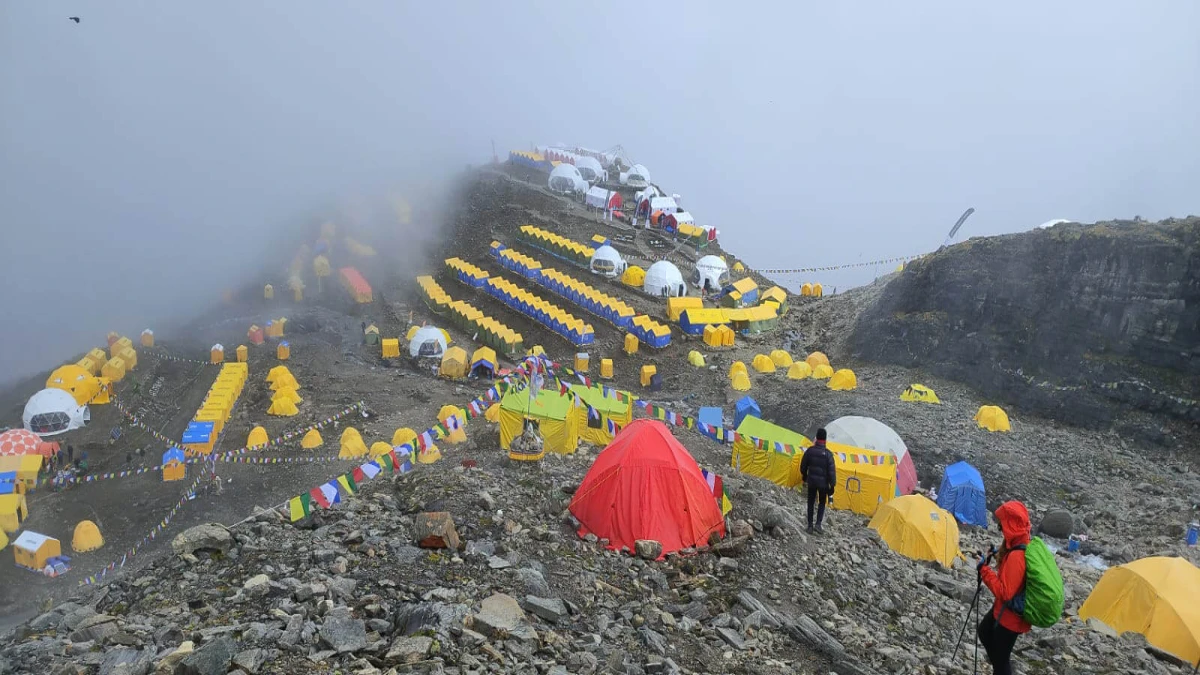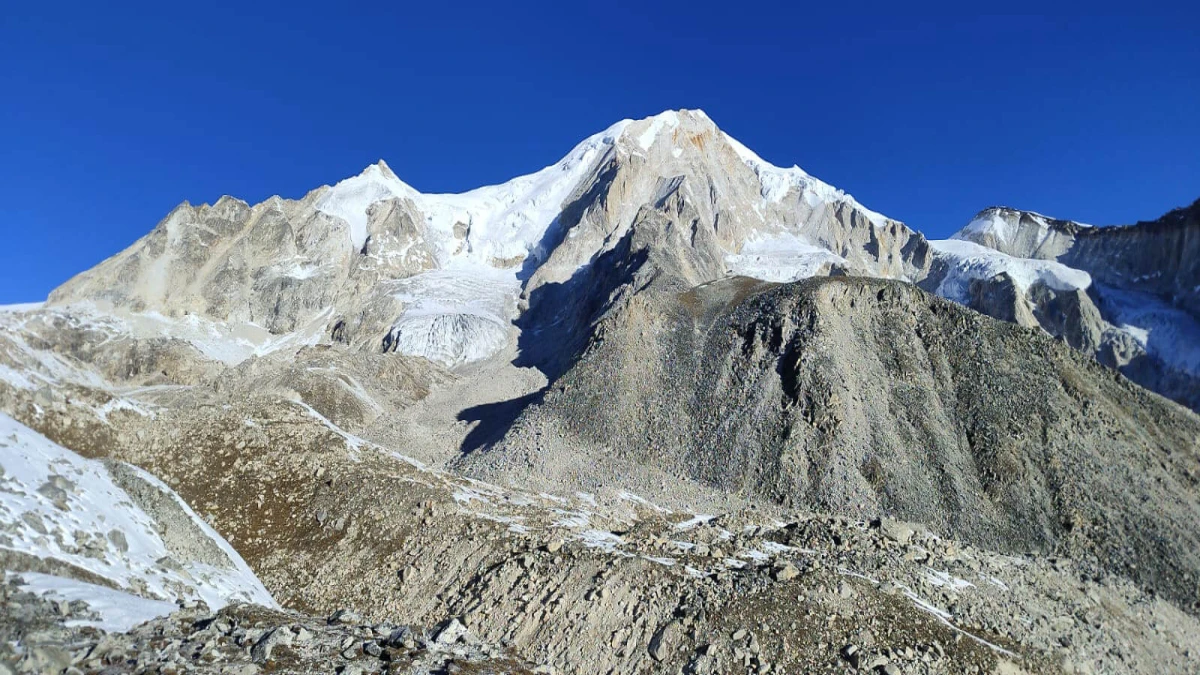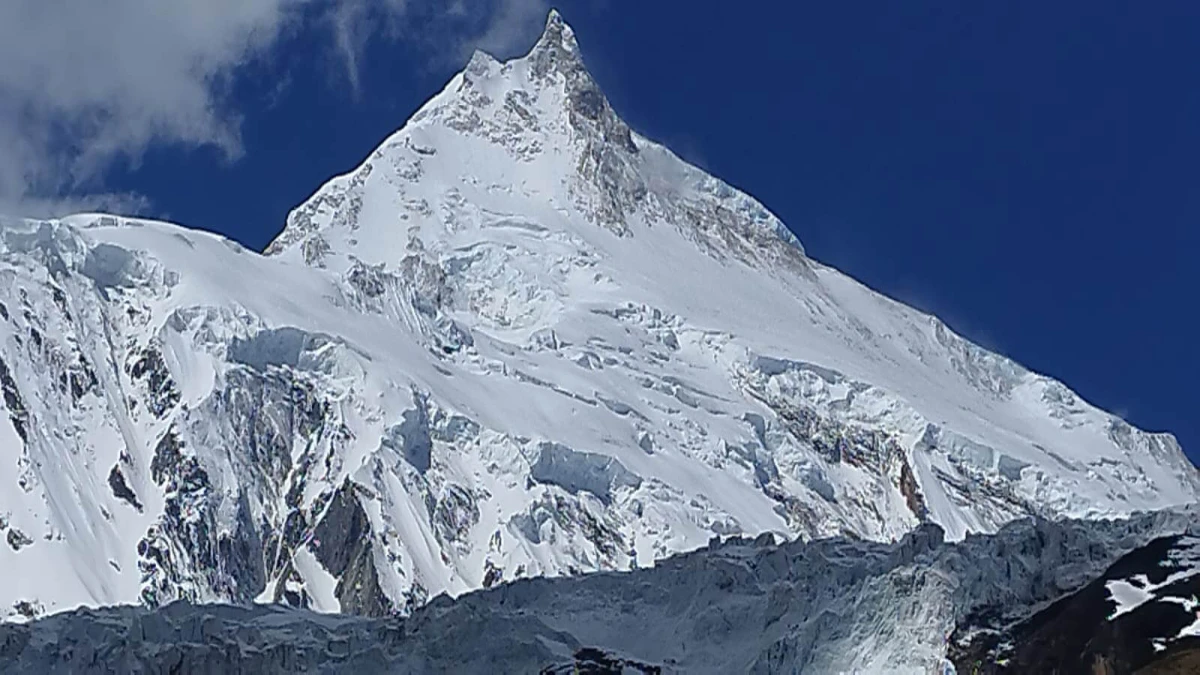Permits & Fees for Manaslu Expedition
Climbing Manaslu (8,163 m) requires careful planning, not just physically, but also legally. You’ll need the permits because the Nepalese government strictly regulates access to the Manaslu region to preserve its natural beauty and ensure climbers safety. Here is everything that you need:
- Manaslu Restricted Area Permit: This is required for trekking and climbing above 8,000 m in the Manaslu region.
- Climbing Permit for Manaslu Summit: This one is mandatory for summit attempts above Base Camp.
- Local Liaison Officer / Government Representative: Each expedition must hire a liaison Officer appointed by the Nepal government. The officer monitors the expedition, safety compliance, and environmental rules.
- Other Permits & Fees: Trekking Information Management System (TIMS) Card, Camping and Environmental Fee, and Insurance.
Packing List for your Manaslu Expedition
Manaslu Expedition covers everything from personal clothing to technical climbing equipment, group gear, and other extra items.
Technical Climbing Equipment
These are essential for glacier travel, steep snow, and summit day.
- Double or Triple Boots: Insulated boots to prevent frostbite even in -30°C.
- Crampons: For additional traction on icy or slippery ground
- Climbing Harness: It is required to attach to the rope and other gear when necessary
- Ice Axe: It is for the stability on steep or icy ground
- Ascender/Descender: It is for climbers, while ascending and descending steep or vertical ground
- Belay/Rappel Device: For controlled rope descent or belaying teammates
- Carabiners: For attaching ropes, gear, and safety lines.
- Prusik/Accessory Cord: For ascending ropes, crevasse rescue, or backup safety knots.
- Helmet: To protect yourself against falling ice or rocks
- Fixed Rope & Dynamic rope: Fixed rope for route security, dynamic rope for team belays or crevasse rescue.
- Snow Bar/Deadman Anchor: Used to secure ropes in snow when placing protection
Clothing Layers
Manaslu Temperature drop below -30°C at higher camps. So, you’ll need supper warm and insulated clothes.
- Base Layers (thermal top & bottom): Moisture-wicking base layer to keep your skin dry.
- Mid Layers (fleece/down jacket): It is an insulation to retain body heat.
- Expedition Down Suit/High-Altitude Down Jacket & Pants: It is extreme cold protection above Camp 3 and the summit push.
- Softshell Jacket & Pants: Windproof and breathable layer for climbing days.
- Shell Jacket & Pants (Gore-Tex): Waterproof outer layer for snowstorms and wind.
- Summit Mittens + Liner Gloves: Keep Hands warm and functional in extreme cold.
- Gaiters: To keep snow out of the boots
- Balaclava / Buff / Facemask: Protects face from frostbite and windburn.
- Down Camp Booties: Warm footwear inside trents.
- Climbing Socks (Multiple Pairs): Warm, moisture-wicking socks for different camps.
Camping and Sleeping Gear
- Expedition Tent (High-Wind Rated): Shelter at higher camps against strong winds.
- Sleeping Bag: To keep you warm during frigid nights.
- Sleeping Pad/Mat (Insulated): Prevents body heat loss through ground.
- Thermos & Water Bottles: Keep water from freezing.
- Cooking Stove: To melt snow and cook at high altitude.
- Fuel Bottles: Store gas/white fuel forr stoves.
Personal Items
- Head lamp and Spare Batteries: For night climbs and early summit start.
- UV-Protected Glacier Sunglasses: Protect eyes from snow blindness.
- Ski Goggles: For high-wind, whiteout, and summit day.
- Sunscreen (SPF 50+) & Lip Balm: Prevent sunburn at high altitude.
- Personal First Aid & Medications: AMS drugs, painkillers, personal prescriptions.
- Climbing Backpack (60-80L): For carrying gear to higher camps.
- Day Pack (30-40L): For acclimatization hikes and short carries.
- Personal Hygiene Kit: Wet wipes, sanitizer, toothbrush, etc.
- Satellite Phone/ Radio: Communication with base camp and rescue.
- Solar Charger/Power Bank: Charging electronics when no power is available.
Technical/Team Equipment (Shared)
- Fixed Rope Stock (Static): For securing routes in a dangerous section
- Oxygen Bottles & Regulator: For summit push if needed.
- Ice Drills & Anchors: Securing fixed ropes on ice walls.
- Ladders: Crossing deep crevasses on glacier routes.
- Satellite GPS Locator: Emergency tracking and SOS.
Tips
- Boots, Crampons, and harnesses must fit perfectly to avoid frostbite or accidents.
- Cheap gear can fail at -30°C, invest in expedition-grade equipment.
- Always carry altitude sickness medicine, even if the team provides a medical kit.
Safety, Altitude Sickness & Medical Planning During the Manaslu Expedition.
Manaslu (8,163 m)climb should be considered as one of the challenging high-altitude mountaineering experiences and the first thing on the climbers minds must be safety. Generally, in the Himalayan region, the climate often changes in a not-so-predictable manner, it is extremely cold and the air is thinner when above 5,500 meters, therefore taking the right steps in preparation, having a good medical plan, and leaving enough time for proper acclimatization can not only be the difference between a successful mountaineering trip but also can save the climbers from serious health risks.
High-Altitude Risks on Manaslu
Altitude sickness during Manaslu expedition is the most common threat. The symptoms might occur when the body struggles to adjust to low oxygen levels. Key conditions include:
- Acute Mountain Sickness (AMS): Headache, nausea, dizziness, fatigue, loss of appetite.
- High Altitude Pulmonary Edema (HAPE): Fluid in lungs, cough, shortness of breath, reduced oxygen saturation. Life-threatening if untreated.
- High Altitude Cerebral Edema (HACE): Swelling of the brain, confusion, poor coordination, coma risk.
Acclimatization Strategy
Proper acclimatization is most important for a safe climb.
- Gradual Ascent: Follow climb high, sleep low principle. Our itinerary in made on this principle.
- Rest Days: There should be enough rest days in your itinerary.
- Monitor Oxygen Levels: Use a pulse oximeter to check SpO2 daily.
Medical Planning Before the Expedition
- Medical Check-Up: Check Cardiac, respiratory, and general health evaluation.
- Vaccinations & Preventive Medicine: For Typhoid, Hepatitis, Tetanus, and Diamox for AMS prevention.
- Personal First-Aid Kit: It should include Painkillers, blister care, bandages, antibiotics, and altitude medications.
- Emergency Evacuation Insurance: It should cover helicopter evacuation and hospital care if needed.
Personal Safety Tips for Climbers
- Train physically and mentally for months before the climb.
- Stay hydrated and eat high-calorie meals.
- Dress in proper layering and never compromise on gloves, down suit, or boots.
- Rest during rest days and don’t rush to the summit.
- Check weather forecasts before moving to higher camps.
Safety in the Manaslu Expedition includes careful acclimatization, medical readiness, experienced guides, and emergency planning. Following these protocols, you can maximize the chances of a successful summit and safe return.
Manaslu Expedition Route
Climbing Manaslu isn’t just a trek it's a full Himalayan Expedition. From Lush River valleys to high camps, this route blends culture, challenges, and pure adventure.
Route of Kathmandu to Base Camp
Kathmandu → Dharapani → Tilije → Bimthang → Samdo → Sama Gaon → Base Camp
The trail passes through Tibetan-influenced villages, suspension bridges, and deep river gorges, offering gradual acclimatization.
Base Camp & High Camps
- Base Camp (~4,800 m): This is the main hub for acclimatization, rotations, and puja ceremony.
- Camp 1 (~5,700 m): Glacier travel and crevasses.
- Camp 2 (~6,400 m): Icefall sections and steep snow slopes.
- Camp 3 (~6,800 m): Exposed ridges, crucial for acclimatization.
- Camp 4 (~7,400 m): Launch point for summit push.
Summit Day (~8,163 m)
- Start late at night from Camp 4 to reach the summit by sunrise.
- Challenges: steep snow ridges, icy slopes, low oxygen.
- Rewards: 360° panoramic Himalayan views.
Descent & Return
- Carefully descend to Base Camp, then return back through Sama Gau and Maccha Khola.
- Finally, transfer to your hotel in Kathmandu.
Food and Accommodation During the Manaslu Climb Trek
The Manaslu Expedition isn’t only about climbing. It’s about the journey through remote Himalayan villages, cozy teahouses, and rugged camps that keep climbers safe on the mountain.
Accommodation on the Manaslu Climb Trek
As you trek from Kathmandu to Manaslu Base Camp, lodging is affected by the altitude. In the lower trails, you’ll stay in Teahouses & Guesthouses, which are simple but welcoming. The rooms have two single beds, blankets, and shared bathrooms. Hot showers and Wi-Fi may be available for a small fee.
In Higher Villages, tea houses are more basic with stone or wooden rooms. Nights will be cold, electricity is limited, and solar charging is at an extra cost. But the stunning views of Manaslu and the surrounding peaks make every stay unforgettable.
Accommodation at Base Camp is in a tent with a central dining tent, kitchen, sleeping tents, and a medical tent. The tent is equipped with solar power, radio communication, and cooking staff. In High Camps from Camp 1 to Camp 4, two-person alpine tents are pitched on snow or ice. There is no dining facilities, and meals are boiled or freeze-dried and cooked by Sherpas. Temperatures can drop to -25°C or lower, so high-quality sleeping bags are essential.
Foods during the Manaslu Trek & Expedition
Fueling your body is the most essential part to achieve summit success. Meals are high in calories and easy to digest. During the trek, you’ll eat traditional Nepali Dal Bhat (rice, lentils, vegetables) as the main dish. Other dishes like Momo dumplings, fried noodles, Tibetan bread, pasta, soups, eggs, and potatoes are also available. You’ll also get Tea, coffee, ginger lemon honey drinks to stay hydrated and warm.
At Base Camp, the cooks will prepare international and Nepali meals like pasta, rice, curry, fresh vegetable soups, porridge, eggs, and hot drinks. Snacks like chocolate, biscuits, and energy bars are also common. At High Camps, Instant soups, energy gels, dry fruits, chocolate, and freeze-dried meals are available. Hydration is maintained here by melting snow for drinking water.
Tips to remain Healthy during the Manaslu climb
- You need to stay hydrated constantly. You should drink 4-5 liters of fluids per day.
- Avoid alcohol and smoking to prevent altitude sickness.
- Carry personal snacks (nuts, protein bars) for quick energy boosts.
- Bring a sleeping bag rated to -25°C for Base Camp and -40°C for high camps.
Best Season for the Manaslu Climb
While climbing Manaslu at 8,163 m. It not only demands strength, but right timing too. Choosing the best season can make your summit safe and tension-free. You can attempt the climb any time of the year but the best season for Manaslu Climb is during Autumn and Spring.
Autumn Season (September-October-Early November)
In this season, the weather brings stable skies, clear mornings, and minimal snowfall. The panoramic Himalayan Views are clearly seen. Day temperature lies between 5°C to 15°C in trekking areas, but it is colder in Base Camps, which lie between -10°C to -20°C at night. This season is also ideal for the summit pushes. The jet stream shifts north by reducing extreme winds on the upper slope. This season comes with the vibrant trekking trails and local festivals like Dashain & Tihar. Also, best for the photographers to capture golden sunsets, crystal-clear peaks, and bright starry nights.
Spring Season (April-May)
This one’s another best season for Manaslu Climbing. The season has Mild Temperatures with longer daylight hours. The temperature in Base Camp is from -5°C to -15°C at night, which is warmer than in autumn. But there is slightly more avalanche risk as the snow softens in the sun. But In early spring season, the glaciers are still packed with winter snow, so natural snow bridges are stronger and safer to walk on, and the ice walls stay solid and stable for climbing. Rhododendron blooms all over the forest along the trail, which is perfect for the trekkers who love vibrant landscapes. The crowds are also fewer compared to the Everest and Annapurna expeditions.
So, the best season for the Manaslu Expedition is Spring, it gives warmer climbs and colourful landscapes and also summit success rates are highest this season. The Autumn Season is another good choice when the weather is stable. But other seasons like winter and Monsoon, are less recommended for climbing. In winter, it is extremely cold, and in the Monsoon, heavy rain falls make the climbing hard.
Conclusion for Manaslu Expedition
Manaslu Expedition isn’t just an attempt to summit another 8000m peak. it’s a journey through the wild without the intervention of the nature lovers of the Himalayas, meeting the most peaceful side of the nature. Starting from the forests of the Manaslu Conservation Area up to the "Spirit of the Mountain", the walk tests your endurance and treats to views almost no one on earth would have witnessed.
Summiting Manaslu gives you:
- A real 8,000 m experience, but with fewer people than Everest or Cho Oyu.
- A suitable combination of technical challenge and cultural experience with villages under Tibetan influence and ancient monasteries on the way.
- The opportunity of being at the eighth-highest point on earth while creating unforgettable memories with your team.
With the right training, acclimatization, and expert guides, the Manaslu climb is achievable for dedicated mountaineers who’re seeking a safer and less commercial alternative to other giants. If you’re ready for a climb that blends raw Himalayan power with quiet spiritual depth, then Manaslu is calling and the time to answer is now. Make your Manaslu Climb Successful with Himalayan Partner.




